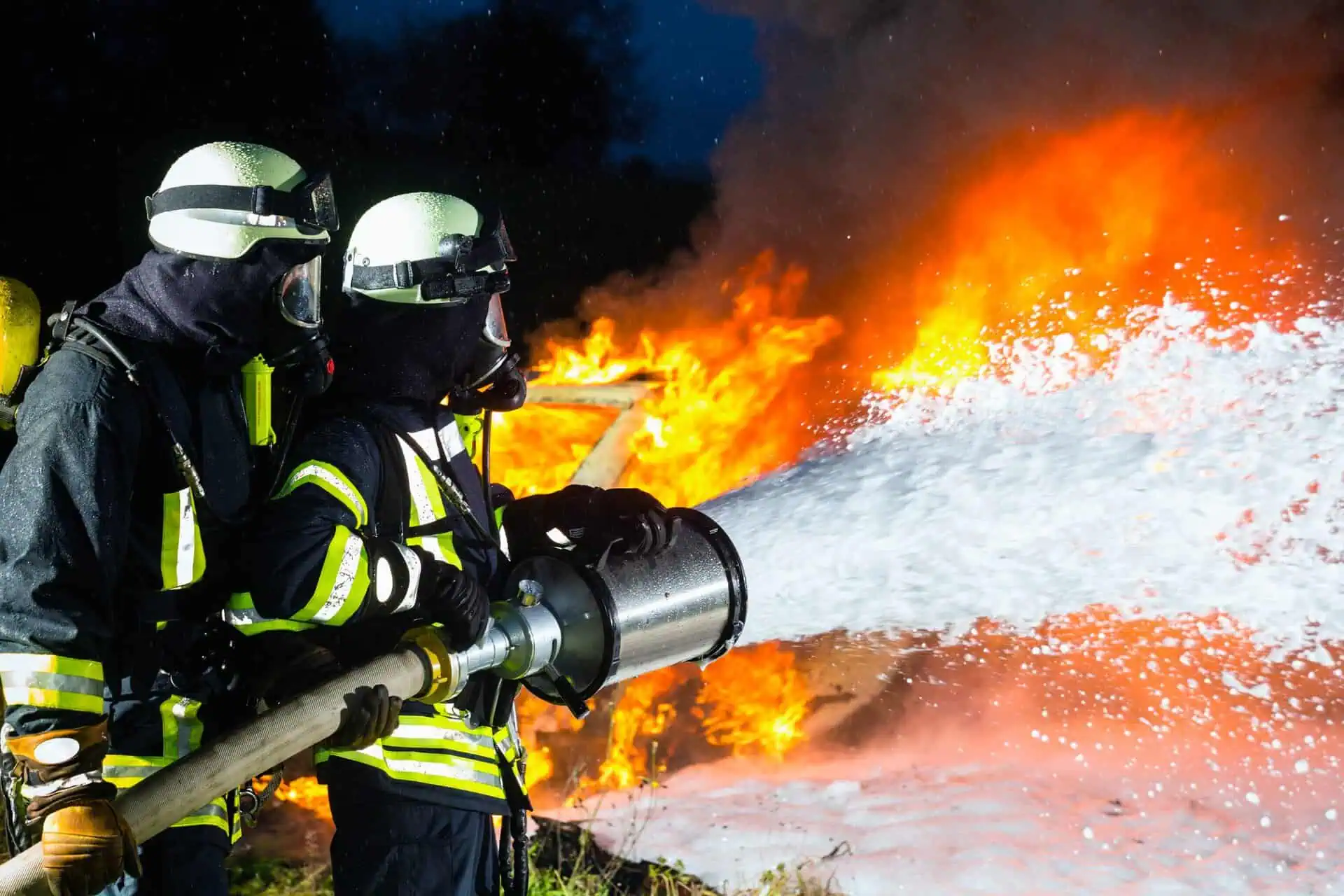Navy AFFF Exposure Claims Process: Firefighter Foam Lawsuit
- Last Updated: June 12th, 2025

Attorney Jessica Paluch-Hoerman, founder of TruLaw, has over 28 years of experience as a personal injury and mass tort attorney, and previously worked as an international tax attorney at Deloitte. Jessie collaborates with attorneys nationwide — enabling her to share reliable, up-to-date legal information with our readers.
Legally Reviewed
This article has been written and reviewed for legal accuracy and clarity by the team of writers and legal experts at TruLaw and is as accurate as possible. This content should not be taken as legal advice from an attorney. If you would like to learn more about our owner and experienced injury lawyer, Jessie Paluch, you can do so here.
Fact-Checked
TruLaw does everything possible to make sure the information in this article is up to date and accurate. If you need specific legal advice about your case, contact us by using the chat on the bottom of this page. This article should not be taken as advice from an attorney.
Key takeaways:
- Navy firefighters and service members face significant exposure risks to AFFF firefighting foam during operations, training exercises, and post-fire cleanup, which can potentially lead to serious health concerns.
- Exposure to AFFF has been linked to an increased risk of kidney, prostate, and testicular cancers, as well as thyroid disease, among Navy firefighters and military personnel.
- Individuals affected by AFFF exposure can seek justice by working with experienced firefighting foam attorneys, like those at TruLaw, to build strong cases and maximize their potential for compensation through AFFF lawsuits.
Overview of Navy AFFF Exposure
On this page, we’ll discuss Navy AFFF Exposure, health risks associated with AFFF exposure in the Navy, how to seek medical care for AFFF-related health issues, and much more.
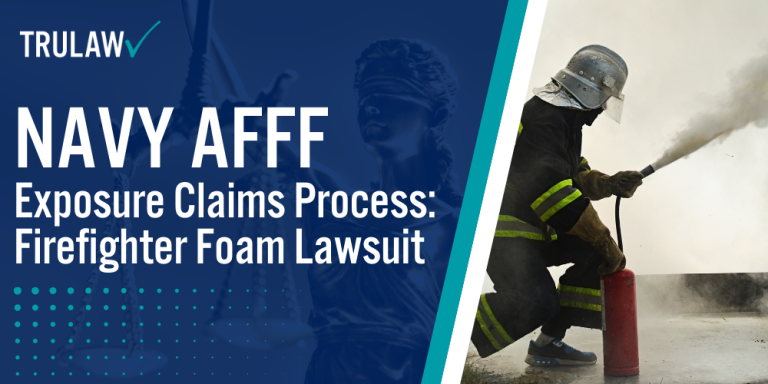
Intro to Navy AFFF Exposure
Navy personnel may have been exposed to AFFF in various ways, including but not limited to:
- Firefighting Training: Many Navy members underwent firefighting training exercises involving AFFF, leading to direct exposure.
- On-Base Fires: When responding to fires on Navy bases, personnel may have come into contact with AFFF.
- Contaminated Drinking Water: AFFF can seep into groundwater, potentially contaminating the drinking water supply on Navy bases.
- Equipment Maintenance: Handling firefighting equipment containing AFFF could result in exposure through skin contact or inhalation.
If you or a loved one served in the Navy and have been diagnosed with cancer or other health issues potentially related to AFFF exposure, you may be eligible for compensation.
Contact TruLaw using the chat feature on this page for a free case evaluation to determine if you qualify for an AFFF lawsuit.
Table of Contents
Widespread Use of AFFF Firefighting Foam in the Navy
The Navy has widely utilized Aqueous Film Forming Foam (AFFF) in various capacities.
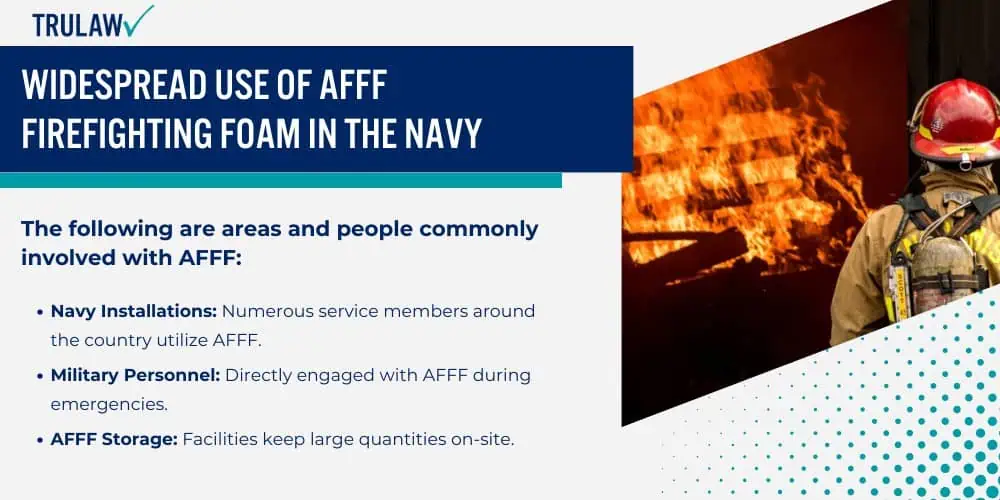
Notably, it is used at installations and bases, during routine maintenance, and in firefighting training exercises.
This has led to lawsuits as concerns over environmental and health impacts come to light.
AFFF: A Staple at Various Navy Installations and Bases
AFFF has been a key firefighting agent at military bases due to its effectiveness against flammable liquids.
It creates a blanket-like foam that suffocates fire by removing oxygen, which is essential for operations involving aircraft and vehicle fires.
The following are areas and people commonly involved with AFFF:
- Navy Installations: Numerous service members around the country utilize AFFF.
- Military Personnel: Directly engaged with AFFF during emergencies.
- AFFF Storage: Facilities keep large quantities on-site.
- Protective Gear Use: Workers wear gear when handling AFFF due to its chemical properties.
In recent years, concerns over AFFF’s environmental impact led to stringent restrictions and ongoing AFFF litigation called the Navy firefighter foam lawsuit.
Routine Equipment Maintenance and Testing with AFFF
Regular maintenance and testing of firefighting equipment are essential, and AFFF plays a significant role in these activities.
These activities could potentially affect the environment and the health of those exposed.
Below are some common uses of AFFF during equipment maintenance and testing:
- Equipment Testing: Liberally used during routine checks.
- Maintenance Procedures: Involved AFFF to ensure readiness.
- Training Scenarios: Simulated environments used AFFF for realism.
- Disposal Practices: Raised questions about the sustainability of AFFF usage and its impact.
Focused legal scrutiny, part of the AFFF firefighting foam MDL, examines the broader implications of such extensive usage.
Extensive Use of AFFF in Navy Firefighting Training Exercises
Firefighting training is rigorous and involves applying AFFF to prepare navy firefighters for real-world scenarios.
Here are some common training exercises that use AFFF:
- Firefighting Drills: Regular drills feature AFFF to extinguish practice fires.
- Live Fire Events: Realistic exercises with AFFF allow for hands-on experience.
- Application Techniques: Trainees learn the optimal use of AFFF in various fire situations.
- Safety Protocols: Instructions include safe handling and usage of AFFF.
As awareness of AFFF’s potential risks grows, the military and other stakeholders re-evaluate its widespread use.
This has led to significant discussions within the context of the firefighting foam controversies.
Exposure Risks for Military Firefighters and Service Members
Military firefighters and service members engaged in operations face risks due to occupational exposure to AFFF firefighting foam.
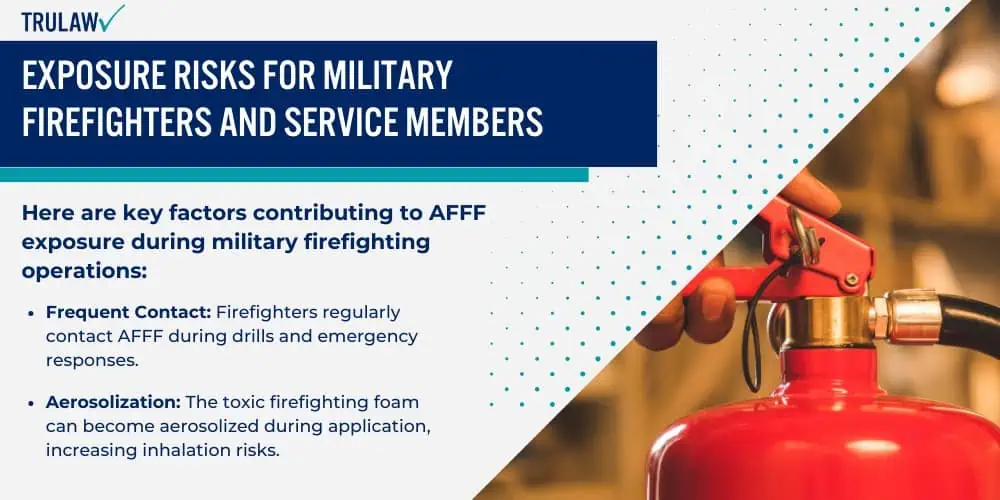
This foam contains PFAS, often called forever chemicals due to their persistence in the environment and the human body.
AFFF Exposure During Firefighting Operations on Ships and Military Airports
Military firefighters frequently use AFFF foam to control and extinguish fires, especially in jet fuel situations.
This foam is highly effective and a significant PFAS exposure source.
Here are key factors contributing to AFFF exposure during military firefighting operations:
- Frequent Contact: Firefighters regularly contact AFFF during drills and emergency responses.
- Aerosolization: The toxic firefighting foam can become aerosolized during application, increasing inhalation risks.
- Surface Contamination: AFFF can contaminate ships’ and military airports’ surfaces, leading to indirect exposure.
- Protection Measures: Although protective gear is used, it may not completely shield firefighters from PFAS exposure.
Post-Fire Suppression Cleanup: A Hidden Danger
The risks associated with AFFF continue even after the flames are extinguished.
Cleanup efforts can be a significant source of toxic exposure.
Here are some common hazards during post-fire suppression cleanup:
- Residual Foam: AFFF residues remain on gear, equipment, and surfaces, requiring careful decontamination.
- Water Runoff: Contaminated water from firefighting can seep into soil and groundwater.
- Improper Handling: Service members might inadvertently spread contaminants without adequate training on handling and disposal.
- Documentation: Thorough reporting of exposure incidents is essential for those who need to file an AFFF class action lawsuit in the future.
In recognizing these risks, service members and firefighters exposed to firefighting foam may consider their legal options to address health concerns related to PFAS exposure.
Known Side Effects of AFFF Firefighting Foam Exposure
Exposure to AFFF firefighting foam has been connected to several serious health concerns affecting Navy firefighters and other military personnel.
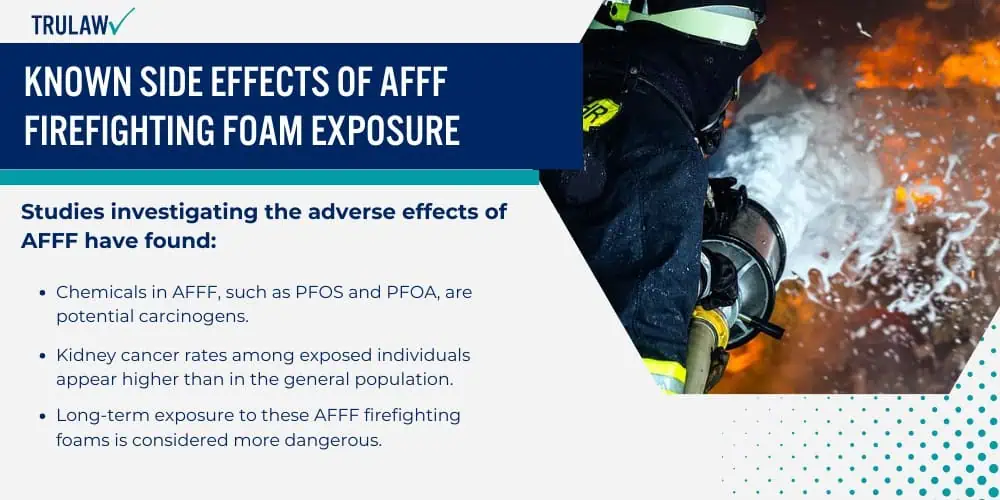
Scientific and medical research has pinpointed an elevated risk for specific types of cancers and other illnesses potentially linked to these chemicals.
Increased Risk of Kidney Cancer Among Navy Firefighters
Exposure to AFFF among Navy firefighters has been notably associated with an increased risk of kidney cancer.
Studies investigating the adverse effects of AFFF have found:
- Chemicals in AFFF, such as PFOS and PFOA, are potential carcinogens.
- Kidney cancer rates among exposed individuals appear higher than in the general population.
- Long-term exposure to these AFFF firefighting foams is considered more dangerous.
- The military is actively researching and addressing these concerns.
Higher Incidence of Prostate Cancer in AFFF-Exposed Personnel
Prostate cancer presents a significant threat to health among military firefighters with AFFF exposure.
Key points include:
- Documented increased occurrence of prostate cancer among AFFF-exposed personnel.
- Military health records indicate a troubling trend correlating AFFF use and this disease.
- Continuous efforts by the Department of Defense to monitor and mitigate these health risks.
- Ongoing legal battles underscore the need for accountability and protection of service members.
Testicular Cancer: A Serious Concern for Navy Firefighters
The link between testicular cancer and AFFF firefighting foam is a serious concern for Navy firefighters.
Research has revealed:
- A higher prevalence of testicular cancer diagnoses among those who have handled AFFF.
- Concerns within the military regarding the health and safety implications of foam use.
- Consequences for human health have led to ongoing studies and policies.
- Recognition and compensation for affected individuals are central themes in AFFF firefighting foam lawsuits.
Thyroid Disease Linked to AFFF Exposure in the Military
AFFF exposure is not only linked to various types of cancer but also to thyroid disease.
Important observations include:
- Military and medical research has established a possible link between AFFF and altered thyroid function.
- Service members exposed to PFAS-containing firefighting foam show a statistically significant occurrence of thyroid problems.
- Chronic exposure may heighten the likelihood of developing thyroid disease.
- Preventative measures and health screenings have become more prevalent as the issue gains visibility.
Environmental Toll of AFFF Firefighting Foam
The use of Aqueous Film Forming Foam (AFFF) in firefighting has raised significant concerns due to its environmental impacts, including water contamination and harm to wildlife.
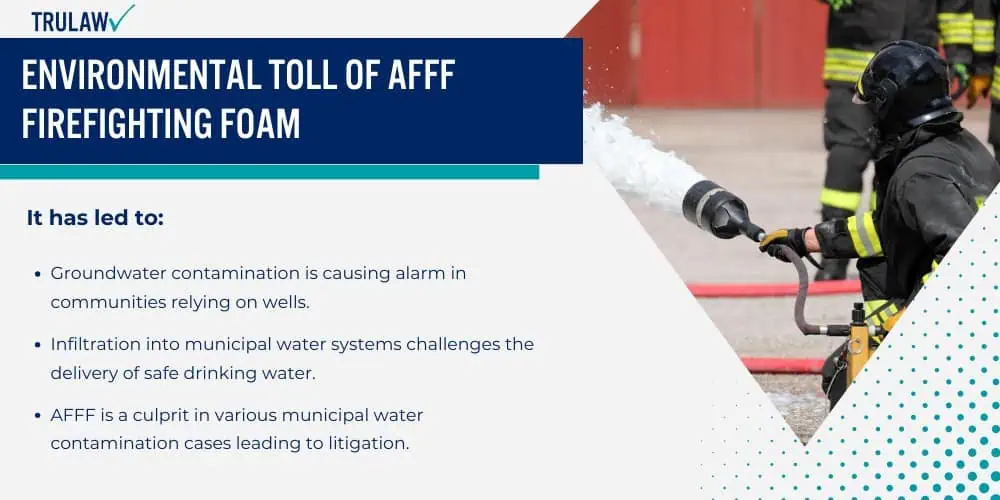
These foams contain PFAS, substances linked to various environmental and health issues.
Groundwater and Surface Water Contamination by AFFF
Groundwater and surface water pollution from AFFF is the first critical issue.
It has led to:
- Groundwater contamination is causing alarm in communities relying on wells.
- Infiltration into municipal water systems challenges the delivery of safe drinking water.
- AFFF is a culprit in various municipal water contamination cases leading to litigation.
- The Environmental Protection Agency (EPA) is taking steps to address and regulate these toxic substances in water sources.
Bioaccumulation: How AFFF Moves Through the Food Chain
AFFF can trigger a process where toxic chemicals incrementally concentrate within organisms, known as bioaccumulation.
Here’s how AFFF affects the food chain:
- Small aquatic creatures ingest PFAS-laden water or sediments.
- Larger predators consume these smaller organisms, accumulating higher PFAS levels.
- Eventually, these chemicals can reach humans who eat affected fish or wildlife.
- Over time, PFAS exposure through bioaccumulation poses risks to both human health and the environment.
Long-Term Ecological Impact: AFFF’s Lasting Effects on Wildlife
The materials in AFFF persist, causing widespread and lasting effects on ecosystems where firefighting foams have been used.
The environmental toll is significant, with current actions seeking to mitigate the damage and prevent future harm.
Determining Your Eligibility for an AFFF Lawsuit
When considering participation in an AFFF lawsuit, individuals must assess their eligibility and prepare accordingly.
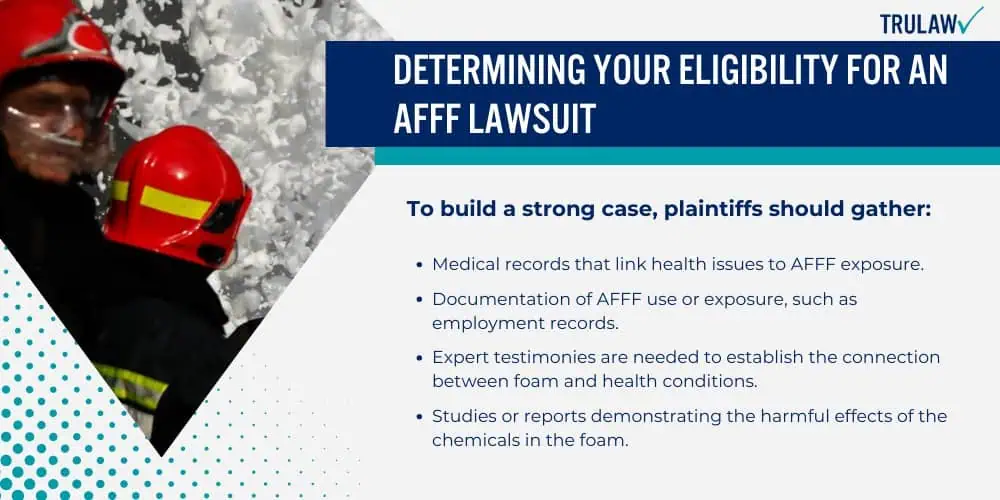
Building a Strong Case: Evidence Needed for AFFF Lawsuits
Evidence is the cornerstone of any AFFF lawsuit.
To build a strong case, plaintiffs should gather:
- Medical records that link health issues to AFFF exposure.
- Documentation of AFFF use or exposure, such as employment records.
- Expert testimonies are needed to establish the connection between foam and health conditions.
- Studies or reports demonstrating the harmful effects of the chemicals in the foam.
Evaluating the Extent of Damages in Firefighting Foam Lawsuits
Assessing the full impact of damages caused by AFFF is essential for legal proceedings.
Plaintiffs should consider:
- The costs of medical treatments, now and anticipated in the future.
- Loss of income due to health-related work absences.
- Pain and suffering associated with health conditions.
- Any other personal impacts on quality of life.
Seeking Justice with TruLaw: Your Trusted Firefighting Foam Attorney
Selecting a trusted attorney is vital for navigating an AFFF lawsuit.
TruLaw and its team of experienced firefighting foam cancer lawyers are equipped to handle:
- Managing the intricacies of AFFF class action MDL.
- Personal injury claims related to firefighting foam exposure.
- Maximizing the Firefighting Foam Cancer Lawsuit settlement potential.
- Providing personalized representation to each client affected by AFFF.
TruLaw: #1 Firefighting Foam Lawyers
TruLaw has decades of experience litigating cases related to firefighting foam.
The AFFF firefighting foam attorneys at TruLaw focus on the impact of AF on human health and the environment, which is caused by the presence of per and poly-fluoroalkyl substances (PFAS) in the foam’s composition.
Why Choose TruLaw’s Firefighting Foam Attorneys?
- Expertise: TruLaw’s attorneys deeply understand the legal landscape surrounding AFFF.
- Experience: They have years of experience in handling cases that involve environmental toxins.
- Commitment: The firm advocates for individuals and communities impacted by AFFF.
- Results: TruLaw boasts a strong track record of securing favorable client outcomes.
As experienced firefighting foam lawyers, TruLaw offers resources and guidance to those affected and works tirelessly to hold responsible parties accountable.
They manage all facets of the litigation process, from initial case evaluation to courtroom representation.
- Case Evaluation: Thorough assessment of potential claims related to AFFF exposure.
- Legal Strategy: Development of a tailored approach to suit individual client needs.
- Litigation Support: Robust support throughout the legal proceedings.
- Resource Allocation: Strategic application of resources to enhance case strength.
TruLaw’s firefighting foam attorneys remain determined to seek justice on behalf of their clients, ensuring informed decision-making and tenacious advocacy at every turn.
AFFF Lawsuit Frequently Asked Questions
-
What are the eligibility criteria for participating in a firefighter foam lawsuit?
The eligibility criteria for filing a lawsuit typically require the plaintiff to have been exposed to AFFF and to have suffered injuries or developed health issues as a result.
Additionally, there may be time limits known as statutes of limitations that dictate the timeframe within which you must file your claim.
-
What are the common symptoms associated with AFFF exposure?
Exposure to firefighting foam chemicals, particularly PFAS, has been linked to various health issues.
Symptoms often include thyroid disorders, developmental effects during pregnancy or to breastfed infants, and certain types of cancer.
-
How are settlement amounts determined in AFFF-related lawsuits?
Settlement amounts in firefighter foam lawsuits are generally based on the extent of exposure, the severity of the injury, the defendant’s degree of negligence, and the financial and emotional impact on the victim.
Each case is assessed on a case-by-case basis to determine fair compensation.
-
What is the current status of litigation regarding firefighter AFFF foam?
Litigation concerning the national firefighter registry AF foam is ongoing, with cases consolidated in multidistrict litigation to streamline the process.
The aim is to resolve claims related to the health impacts of exposure to PFAS chemicals in firefighting foams used by military and civilian firefighters.
-
How have previous VA claims for AFFF exposure been adjudicated?
Previous VA claims have been varied in their outcomes.
Some veterans received compensation for health impacts linked to AFFF exposure, while others were denied.
The adjudication hinges on the ability to demonstrate a connection between service-related AFFF exposure and subsequent health issues.
-
Are claims against military gas chamber exposure related to AFFF lawsuits?
Claims against military gas chamber exposure are not typically associated with AFFF lawsuits.
AFFF lawsuits focus specifically on exposure to certain chemicals found in firefighting foams and the resulting adverse health effects.
-
Are Firefighting Foam Manufacturers Being Held Accountable for AFFF Exposure?
Firefighting foam manufacturers are facing legal action due to the adverse health and environmental effects of AFFF (Aqueous Film Forming Foam), which contains perfluoroalkyl and poly-fluoroalkyl substances (PFAS).
Lawsuits allege that these manufacturers were aware of the risks but continued to produce and market AFFF to military and civilian organizations without adequate warnings.
As a result, numerous lawsuits have been filed against these manufacturers, seeking compensation for medical costs, loss of income, and other damages related to exposure to AFFF foam.

Managing Attorney & Owner
With over 25 years of legal experience, Jessica Paluch-Hoerman is an Illinois lawyer, a CPA, and a mother of three. She spent the first decade of her career working as an international tax attorney at Deloitte.
In 2009, Jessie co-founded her own law firm with her husband – which has scaled to over 30 employees since its conception.
In 2016, Jessie founded TruLaw, which allows her to collaborate with attorneys and legal experts across the United States on a daily basis. This hypervaluable network of experts is what enables her to share the most reliable, accurate, and up-to-date legal information with our readers!
Additional AFFF Lawsuit resources on our website:
Here, at TruLaw, we’re committed to helping victims get the justice they deserve.
Alongside our partner law firms, we have successfully collected over $3 Billion in verdicts and settlements on behalf of injured individuals.
Would you like our help?
At TruLaw, we fiercely combat corporations that endanger individuals’ well-being. If you’ve suffered injuries and believe these well-funded entities should be held accountable, we’re here for you.
With TruLaw, you gain access to successful and seasoned lawyers who maximize your chances of success. Our lawyers invest in you—they do not receive a dime until your lawsuit reaches a successful resolution!
AFFF Lawsuit claims are being filed against manufacturers of aqueous film-forming foam (AFFF), commonly used in firefighting.
Claims allege that companies such as 3M, DuPont, and Tyco Fire Products failed to adequately warn users about the potential dangers of AFFF exposure — including increased risks of various cancers and diseases.
Depo Provera Lawsuit claims are being filed by individuals who allege they developed meningioma (a type of brain tumor) after receiving Depo-Provera birth control injections.
A 2024 study found that women using Depo-Provera for at least 1 year are five times more likely to develop meningioma brain tumors compared to those not using the drug.
Suboxone Tooth Decay Lawsuit claims are being filed against Indivior, the manufacturer of Suboxone, a medication used to treat opioid addiction.
Claims allege that Indivior failed to adequately warn users about the potential dangers of severe tooth decay and dental injuries associated with Suboxone’s sublingual film version.
Social Media Harm Lawsuits are being filed against social media companies for allegedly causing mental health issues in children and teens.
Claims allege that companies like Meta, Google, ByteDance, and Snap designed addictive platforms that led to anxiety, depression, and other mental health issues without adequately warning users or parents.
Transvaginal Mesh Lawsuits are being filed against manufacturers of transvaginal mesh products used to treat pelvic organ prolapse (POP) and stress urinary incontinence (SUI).
Claims allege that companies like Ethicon, C.R. Bard, and Boston Scientific failed to adequately warn about potential dangers — including erosion, pain, and infection.
Bair Hugger Warming Blanket Lawsuits involve claims against 3M — alleging their surgical warming blankets caused severe infections and complications (particularly in hip and knee replacement surgeries).
Plaintiffs claim 3M failed to warn about potential risks — despite knowing about increased risk of deep joint infections since 2011.
Baby Formula NEC Lawsuit claims are being filed against manufacturers of cow’s milk-based baby formula products.
Claims allege that companies like Abbott Laboratories (Similac) and Mead Johnson & Company (Enfamil) failed to warn about the increased risk of necrotizing enterocolitis (NEC) in premature infants.
Here, at TruLaw, we’re committed to helping victims get the justice they deserve.
Alongside our partner law firms, we have successfully collected over $3 Billion in verdicts and settlements on behalf of injured individuals.
Would you like our help?
